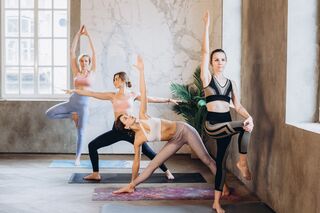Body Image
Are Yoga Pants Bad for Body Image?
Athleisure may trigger women’s body dissatisfaction.
Posted August 24, 2021 Reviewed by Abigail Fagan
Key points
- The athleisure industry has grown significantly, particularly throughout 2020.
- In a small study, women reported that they believed wearing athlesiure reflected a healthy lifestyle and encouraged them to exercise.
- Women whose bodies didn't match a perceived ideal reported feeling self-conscious and uncomfortable wearing athleisure.
Have you found yourself in your exercise gear more often than not in these COVID times? I certainly have. As a matter of fact, I am writing this post, working from home, in my comfortable Lululemon clothing.
I am obviously not the only one living up to the promise of athleisure, clothing designed for both exercise and general use. Athleisure accounted for almost a quarter of the total apparel sales in the United States in 2018, growing 22 percent in the first part of 2020 despite the closure of many fitness centers (Lipsona, Stewart & Griffiths, 2019; Perri, 2021). Comfortable to wear, it is ideal for working at home, but in public, the form-fitting athleisure exposes women’s figures to a potentially critical public gaze.
The contradictions between comfort and gaze have not gone unnoticed by researchers, who are concerned about the impact of the multibillion-dollar business of athleisure fashion on women’s body image. In their recent study, Lipsona and her colleagues (2019) examined how athleisure wearers feel about their bodies.

The researchers interviewed 20 women aged 18-38 who are avid athleisure wearers. Half of the interviewees were white. All participants were well educated and classified as middle or upper class. They lived globally in the U.S., Canada, Australia, New Zealand, and the UK. The researchers indicated that “participants constituted a diverse sample in terms of body weight and body shape” (p. 7).
All participants in this study believed that wearing athleisure reflected a healthy lifestyle. This lifestyle included having a healthy diet of fruit and vegetables (and avoiding such unhealthy foods as cakes and pizza), regular exercise, and attention to mental health. As one participant elaborated: “you also need to have a healthy mind, as well. You have to have positivity to lead a healthy lifestyle” (p. 8).
Athleisure wearers were considered positive, polished, accomplished, and successful women who were self-confident, happy, and friendly. As regular exercisers, they were also disciplined, committed, and hard-working. The participants found information to support their understanding of a healthy lifestyle in such social media outlets as Instagram. The researchers noted, however, that this information appeared confusing as none of the participants was able to give a succinct definition of a healthy lifestyle.
Working out definitely characterized athleisure wearers whose main inspiration to exercise was an improved body shape: they felt better because they looked better after working out. One participant described: “I feel better, you work, exercise harder if you look good” (p. 9). The ‘look good, feel good, work out harder’ sentiment, the researchers found, was common among the participants who defined exercise as a gateway to feeling positive about wearing the form-fitting athleisure.
The participants also indicated that some body types were not suitable for this type of clothing. For example, bodies of higher weight did not appear to their advantage in the revealing athleisure that, as they indicated, was designed for thinner bodies. One participant explained: “I’ll define that [some of her friends’ bodies are] a bit too heavy in the thighs and sometimes [athleisure clothes are] much too tight around their boobs. It’s catered towards a more I would say a skinnier body type than what they really are.” (p. 8)

Athleisure, the women believed, was designed for a thin and toned type that was also associated with a healthy lifestyle. Women with other body types often reported feeling self-conscious and uncomfortable wearing these clothes, because their bodies did not match the ideal. Some other participants judged these athleisure wearers as “more like the lazy kind or the kind that’s like ‘I don’t want to put on jeans so I’m just going to wear these shorts and shirt and I don’t care’” (p. 9).
On the other hand, a woman with a large body in athleisure was also seen as on her way into the thin body ideal. She had started to exercise to lose weight and change her body. The participants with larger bodies did feel that weight loss was a prerequisite for wearing athleisure as one participant recollected: “So I think it was when I decided to lose weight, and when I started to lose weight...and once the pounds like started shedding, that’s when I was expanding my wardrobe [to include athleisure].” (p. 9).
After weight loss, these women were more comfortable in athleisure, but did not wear it outside of the gym until their bodies entirely changed from fatter to thinner and toned. As such, athleisure served as a continuous reinforcement for the quest for a better body. For one participant, it helped to set a goal for continued motivation to exercise: “It [athleisure] motivates me. It does, because it tells me that [I’m ready to exercise]…For some reason, it kind of makes me picture a long-term goal. I can see myself on the other side and see myself healthy…I would say my clothing definitely motivates me to reach any kind of healthy lifestyle, or weight goal.” (p. 9)
This motivation was further reinforced by the internet fitspirational models who this participant thought epitomised a healthy lifestyle: “I think people are more trying to buy this activewear and these items...to...think that they’re achieving the same things as these [fitspiration] models these websites are selling…But, they’re buying these objects to, I think, make them feel...like they’re more like these models...to get that lifestyle.” (p. 9)
The researchers indicated that athleisure effectively revealed bodily flaws which then made the participants dissatisfied with their bodies. This, however, was seen as further motivation to work out. “When I wear the more form-fitting stuff,” one participant explained, “it lets me see exactly what I need to work on” (p. 9).
Another continued: “That [when I don’t like how athleisure looks] will also push me to try maybe a little harder, like, okay, I don’t love how this looks, but maybe I should work on it. You know, if I have the tummy...it would be something that’ll help me maybe get more in shape in that area.” (p. 9)
For some participants, athleisure emphasized the bodily flaws to an extent of needing cosmetic surgery: “I realize these are my problem areas and they are not really going away. It’s going to spur me to do a lot more, to take on more extreme measures to get rid of it. And it’s also brought up thoughts about...plastic surgery, or possible plastic surgery options to get rid of it.” (p. 9)
At the same time, athleisure made visible the progress that women had made toward the thin and toned body ideal. One participant offered this perspective: “You can actually see visible like muscle pump at the end of a workout. Because you can see it right there it’s kind of immediate feedback and you’re like, okay, like not only do I feel good because I’ve [done] something productive that I enjoy and that’s good for me. I can actually see it.” (p. 9)

While its form-fitting material revealed every perceived flaw, it was also used to disguise certain body parts to create a visual illusion of an improved body shape. If the toned arms and legs were flaunted when wearing athleisure, it was also used to camouflage the stomach area. It enabled women to emphasize their breasts and buttocks with high-waisted leggings to draw attention to a slim waist to create a “Spanx-type of effect” (p. 10) of a feminine body shape.
Based on their interviews, the researchers suggested that athleisure highlights the feminine, thin and toned body aesthetics more than functionality or health. When revealing body flaws, the form-fitting clothes emphasize the ways that women do not match the fit ideal. Tightly contouring the body, athleisure openly encourages body comparisons that may trigger body dissatisfaction.
Considering their emphasis on the thin and toned body shape, the participants, in a curious contradiction, found the fitspiration image unrealistic and described it as “unattainable” and “unachievable” (p. 10). They openly criticized the athleisure of promoting unrealistic body standards, extreme lifestyle restrictions, and sexualization of women’s bodies.
Yet, many of the participants felt inadequate and bad about their bodies. They were self-critical and blamed themselves for not living up to the fit body ideal or its healthy lifestyle. While they associated athleisure with health, it was closely intertwined with aspirations for the ideal body shape. Although designed to wear outside of the gym, that seemed acceptable only for women with the appropriate thin and toned looks.
References
Lipsona, S. M., Stewart, S., & Griffiths, S. (2019). Athleisure: A qualitative investigation of a multi-billion-dollar clothing trend. Body Image, 32 (2020) 5–13.
Perri, J. (2021, March 10). Athleisure brands stay active during COVID era. https://secondmeasure.com/datapoints/athleisure-brands-stay-active-duri…




